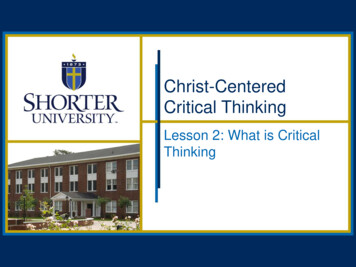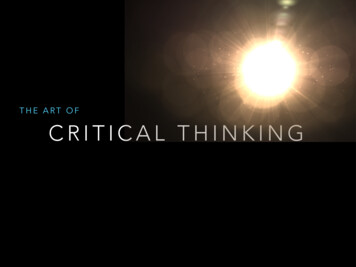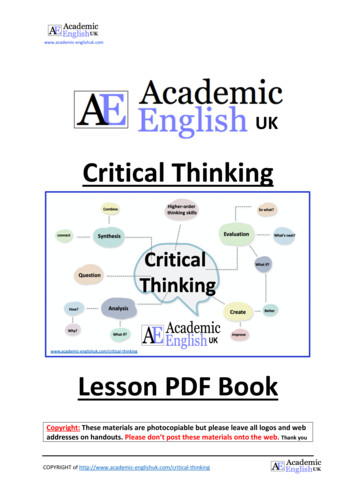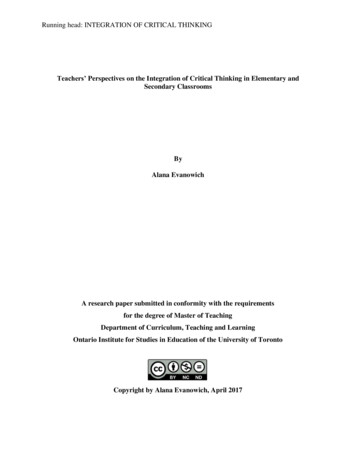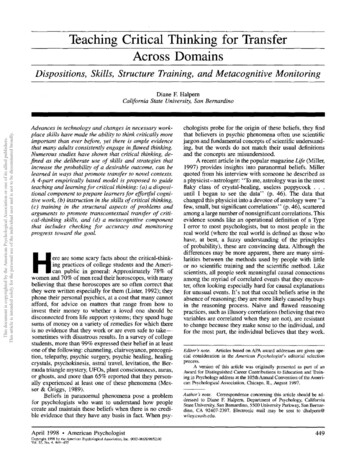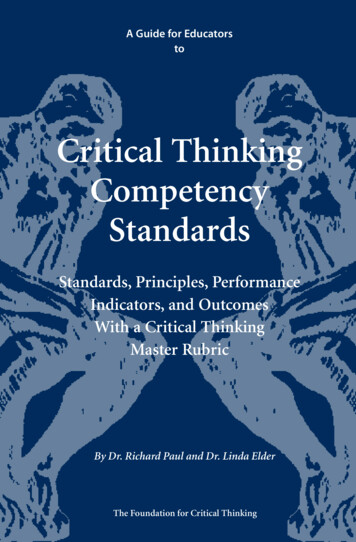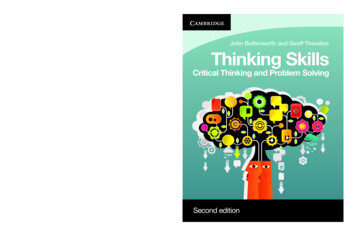
Transcription
Second edition Cover C M Y KThinking SkillsJohn Butterworth and Geoff ThwaitSecond editionJohn Butterworth and Geoff ThwaitesThis lively coursebook encourages students to develop moresophisticated and mature thinking processes by learning specific,transferable skills independent of subject content which assist confidentengagement in argument and reasoning.As well as giving a thorough grounding in critical thinking and problemsolving, the book discusses how to analyse and evaluate arguments,manipulate numerical and graphical information and develop a range ofskills including data handling, logic and reasoning.The second edition of the book has been substantially updated with newand revised content throughout. The only endorsed coursebook offeringcomplete coverage of the Cambridge AS and A Level Thinking Skillssyllabus, this resource also contains extensive extra material to cover awide range of related awards.Features include: clearly focused and differentiated critical thinking and problem solvingunits that provide complete coverage of the Thinking Skills syllabusand beyond a range of stimulating student activities with commentaries to developanalytical skills summary of key concepts at the end of each chapter to review learning end-of-chapter assignments to reinforce knowledge and skills, withanswers at the back for self-assessment a mapping grid to demonstrate the applicability of each unit to awardsincluding Critical Thinking, BMAT and TSA.Thinking Skills is written by two experienced examiners, who haveproduced a lively and accessible text which all students of Thinking Skillswill find invaluable.Visit education.cambridge.org/cie for information on our full range ofCambridge International A Level titles including e-book versions andmobile apps.John Butterworth and Geoff ThwaitesThinking SkillsCritical Thinking and Problem SolvingButterworth and Thwaites9781107606302Critical Thinking and Problem SolvingThinking SkillsThinking SkillsISBN 978-1-107-66996-3Second edition
John Butterworth and Geoff ThwaitesThinking SkillsCritical Thinking and Problem SolvingSecond edition
cambridge university pressCambridge, New York, Melbourne, Madrid, Cape Town,Singapore, São Paulo, Delhi, Mexico CityCambridge University PressThe Edinburgh Building, Cambridge CB2 8RU, UKwww.cambridge.orgInformation on this title: www.cambridge.org/9781107606302 Cambridge University Press 2005, 2013This publication is in copyright. Subject to statutory exceptionand to the provisions of relevant collective licensing agreements,no reproduction of any part may take place without the writtenpermission of Cambridge University Press.First published 2005Second edition 2013Printed in Italy by L.E.G.O. S.p.A.A catalogue record for this publication is available from the British LibraryISBN 978-1-107-60630-2 PaperbackCambridge University Press has no responsibility for the persistence oraccuracy of URLs for external or third-party internet websites referred to inthis publication, and does not guarantee that any content on such websites is,or will remain, accurate or appropriate. Information regarding prices, traveltimetables and other factual information given in this work is correct atthe time of first printing but Cambridge University Press does not guaranteethe accuracy of such information thereafter.
ContentsUnit 1 Thinking and reasoning1.1 Thinking as a skill 1.2 An introduction to critical thinking 1.3 Solutions not problems 1713Unit 2 Critical thinking: the basics 2.12.22.32.42.52.62.72.82.92.10Claims, assertions, statements Judging claims Argument Identifying arguments Analysing arguments Complex arguments Conclusions Reasons Assumptions Flaws and fallacies 16212833384350586370Unit 3 Problem solving: basic skills 3.1 What do we mean by a ‘problem’? 3.2 How do we solve problems? 3.3 Selecting and using information 3.4 Processing data 3.5 Finding methods of solution 3.6 Solving problems by searching 3.7 Recognising patterns 3.8 Hypotheses, reasons, explanations and inference 3.9 Spatial reasoning 3.10 Necessity and sufficiency 3.11 Choosing and using models 3.12 Making choices and decisions 798286909398102106112116119123Unit 4 Applied critical thinking 4.14.24.34.44.54.6Inference Explanation Evidence Credibility Two case studies Critical thinking and science 126137144150156163Contents iii
4.7 Introducing longer arguments 4.8 Applying analysis skills 4.9 Critical evaluation 4.10 Responding with further argument 4.11 A self-assessment 170177183191195Unit 5 Advanced problem solving 5.1 Combining skills – using imagination 5.2 Developing models 5.3 Carrying out investigations 5.4 Data analysis and inference 205211220225Unit 6 Problem solving: further techniques 6.1 Using other mathematical methods 6.2 Graphical methods of solution 6.3 Probability, tree diagrams and decision trees 6.4 Have you solved it? 231235240246Unit 7 Critical reasoning: Advanced Level 7.1 Conditions and conditionals 7.2 Soundness and validity: a taste of logic 7.3 Non-deductive reasoning 7.4 Reasoning with statistics 7.5 Decision making 7.6 Principles 7.7 An argument under the microscope 7.8 Critical writing Answers to assignments Appendix Acknowledgements Index ivContents249254262269279287295301311342344345
Unit 1 Thinking and reasoning1.1 Thinking as a skillThis book is about thinking. But it is not aboutany thinking. It is about those kinds ofthinking that take conscious effort, and whichcan be done well or badly. Most of ourthinking takes little or no conscious effort. Wejust do it. You could almost say that we thinkwithout thinking! If I am asked whether Iwould like coffee or tea, I don’t have toexercise skill to reply appropriately. Similarly ifI am asked a factual question, and I know theanswer, it takes no skill to give it. Expressing apreference or stating a fact are not inthemselves thinking skills. There are languageand communication skills involved, of course,and these are very considerable skills in theirown right. But they are contributory skills tothe activities which we are calling ‘thinking’.This distinction is often made by assigningsome skills a ‘higher order’ than others. Muchwork has been done by psychologists,educationalists, philosophers and others toclassify and even rank different kinds ofthinking. Most would agree that activitiessuch as analysis, evaluation, problem solvingand decision making present a higher order ofchallenge than simply knowing or recalling orunderstanding facts. What distinguisheshigher orders of thinking is that they applyknowledge, and adapt it to different purposes.They require initiative and independence onthe part of the thinker. It is skills of this orderthat form the content of this book.Skills are acquired, improved, and judgedby performance. In judging any skill, thereare two key criteria: (1) the expertise withwhich a task is carried out; (2) the difficulty ofthe task. We are very familiar with this in thecase of physical skills. There are basic skillslike walking and running and jumping; andthere are advanced skills like gymnastics orwoodwork or piano playing. It doesn’t makemuch sense to talk about jumping ‘well’unless you mean jumping a significantdistance, or clearing a high bar, orsomersaulting in mid-air and landing onyour feet. There has to be a degree ofchallenge in the task. But even when thechallenge is met, there is still more to be saidabout the quality of the performance. Onegymnast may look clumsy and untidy,another perfectly controlled and balanced.Both have performed the somersault, but onehas done it better than the other: with moreeconomy of effort, and more skilfully.The first of these two criteria also applies tothinking. Once we have learned to count andadd, tell the time, read and understand a text,recognise shapes, and so on, we do thesethings without further thought, and we don’treally regard them as skilled. You don’t haveto think ‘hard’ unless there is a hard problemto solve, a decision to make, or a difficultconcept to understand. So, as with physicalperformance, we judge thinking partly by thedegree of challenge posed by the task. If astudent can solve a difficult problem, withina set time, that is usually judged as a sign ofgreater skill than solving an easier one.However, when it comes to assessing thequality of someone’s thinking, matters aremore complicated. Mental performance islargely hidden inside a person’s head, unlikephysical performance which is very visible. Iftwo students give the same right answer to aquestion, there is no telling from the answeralone how it was reached. One of the twomay simply have known the answer, or havelearned a mechanical way to obtain it – or1.1 Thinking as a skill 1
even just guessed it. The other may haveworked it out independently, by reasoningand persistence and imagination. Althoughthe difference may not show from the answergiven, the second student scores over the firstin the long term, because he or she has theability to adapt to different challenges. Thefirst is limited to what he or she knew andcould recall, or simply guessed correctly.ReasoningReasoning is the ability most closelyassociated with human advancement. It isoften cited as the faculty which marks thedifference between humans and otheranimals. The famous apes studied by thepsychologist Wolfgang Köhler learned ways toovercome problems, such as using a stick toget at food that was beyond their reach; butthey discovered the solution by trial and error,and then remembered it for the next time.This is evidence of animal intelligence, andcertainly of skill; but it is not evidence thatapes can ‘reason’. As far as we can tell, noanimal ever draws conclusions on the basis ofobservable facts. None of Köhler’s apesthought anything like, ‘That banana is furtherfrom the bars than the length of my arm.Therefore I need to find a stick’; or ‘If thisstick is too short, I will need a longer one.’Reasoning is the process by which weadvance from what we know already to newknowledge and understanding. Being rationalis recognising that from some facts or beliefsothers follow, and using that understandingto make decisions or form judgements withconfidence. If there is one overriding aim ofthis book it is to improve students’confidence in reasoning.Creative thinkingReasoning is not the only higher thinkingskill, nor the only kind of rationality.Imaginative and creative activities are no lessimportant in the history of humandevelopment and achievement. But that is not2Unit 1 Thinking and reasoningto suggest that there are two distinct ways ofthinking: cold hard reason on one hand andfree-ranging creativity on the other. In fact,there is so much overlap and interdependencebetween the two that it is very difficult to saywhere one begins and the other ends. Clearlythere are times when a seemingly insolubleproblem has been cracked by an imaginativeleap rather than a methodical process. Some ofthe greatest advances in science have been theresult of creative thinking that appeared toconflict with reason when first put forward.Yet it is just as clear that many apparentflashes of genius, which seem to come ‘out ofthe blue’, actually come on the back of a lot ofcareful and methodical work. Likewise, newand creative ideas have to be understood andexplained to be of any practical value.Reasoning is required both to enable and toapply creative thinking, just as creativethinking is needed to give a spark toreasoning.ReflectionAnother quality that is evidently exclusive tohuman thinking is reflection. Reflectingmeans giving deep or serious or concentratedthought to something, beyond the immediateresponse to stimuli. When we are engaged inreflection we don’t just make up our minds onimpulse, but carefully consider alternatives,think about consequences, weigh up availableevidence, draw conclusions, test hypothesesand so on. Critical thinking, problem solvingand decision making are all forms of reflectivethinking.Moreover, the reflective thinker does notfocus only on the problem to be solved, thedecision to be made, or the argument to bewon, but also on the reasoning processes thatgo into those activities. Reflecting on the waywe think – or thinking about thinking – helpsus to evaluate how effective our thinking is,what its strengths are, where it sometimesgoes wrong and, most importantly, how itcan be improved.
Using this bookThroughout the book there are activities anddiscussion topics to prompt and encouragereflection on thinking and reasoningthemselves. At regular intervals in the chaptersyou will find ‘Activity’ panels. You can usethese as opportunities to close the book, orcover up the rest of the page, and think or talk– or both – about the question or task. Eachactivity is followed by a commentary offeringan appropriate answer, or some guidance onthe task, before returning to the chapter. Bycomparing the discussion or solution in thecommentary with your own reflections andresponses, you can judge whether to go backand look at a section again, or whether tomove on to the next one.Although it is not essential to do all of theseactivities, you are strongly urged to give sometime to them, as they will help greatly withyour understanding of the concepts andprocedures that make up the Thinking Skillssyllabus. The tasks also act as opportunities forself-assessment, both of your own personalresponses, and of those of your colleagues ifyou are working in groups. Small-groupdiscussion of the tasks is particularly valuablebecause it gives you insight into other ways tothink and reason besides your own. You havethe opportunity to compare your responseswith those of others, as well as with theresponses suggested in the commentary. Theactivities and commentaries are like a dialoguebetween you and the authors of the book.The book can be used either for a school orcollege course in thinking skills, or by the studentfor individual study. It is divided into seven unitswith varying numbers of chapters within them.Although it is not a straight-line progression,there is an overall advance from basic skills toapplied skills and to higher levels of challenge.Preparing for examinationsThe backbone of this book is the Cambridgesyllabus for A and AS Level Thinking Skills. Allof the assessment objectives for thatexamination are covered, though notnecessarily in the same order as they appear inthe specification. The book does not followthe syllabus step by step or confine itself tojust one examination. If it did it would nothelp you either to think more effectively or todo well in your exam. Critical thinking andproblem solving are very broad skills, notbodies of knowledge to be learned andrepeated. A competent thinker is one who isable to deal with the unexpected as well as theexpected. This book therefore takes you wellbeyond the content of one particular examand equips you with a deeper understandingof the processes involved, as well as a flexible,adaptive approach to the tasks you are set.Because thinking skills are general andtransferable, the topics and concepts dealtwith in the coming units will also prepareyou for many other awards that involvecritical thinking and/or problem solving. Thetable on pages 342–43 shows a range ofpublic examinations and admissions testswhose content is covered by some or all ofthe chapters. These include A Level CriticalThinking (OCR and AQA); the BioMedicalAdmissions Test (BMAT); CambridgeThinking Skills Assessment (TSA); SingaporeH2 Knowledge and Inquiry; and Theoryof Knowledge in the InternationalBaccalaureate (IB).Other subjectsFinally, the value of developing your thinkingskills extends far beyond passing exams called‘Thinking Skills’! It has been shown,unsurprisingly, that confidence and aptitudein critical thinking and problem solving willassist students to achieve higher grades acrossall the subjects that they study. Accordinglyyou will find critical thinking, problemsolving and presenting well-reasonedargument among the learning and assessmentobjectives of just about every senior-school oruniversity course, whether in the sciences orthe arts and humanities.1.1 Thinking as a skill 3
Beyond that, too, these are sought-afterqualities in a great many professions andoccupations. Hardly surprisingly, employerswant staff who can think for themselves,solve problems, make decisions andconstruct arguments.What to expectTo give a taste of the structure and style of thebook, this chapter ends with an activitysimilar to those which appear at regularintervals in all of the coming units. You canthink of it as a trial run. The task is to solve apuzzle entitled ‘The Jailhouse Key’. It is asimple puzzle, but it introduces some of thereasoning skills you will encounter in futurechapters, giving a foretaste of all of threedisciplines: problem solving, critical thinkingand decision making.ActivityTwo prisoners are held in a dungeon. Onenight a mysterious visitor appears in their celland offers them a chance to escape. It isonly a chance because they must first reasonto a decision which will determine whether ornot they actually do go free.Their cell is at the bottom of a long flightof steps. At the top is the outer door. Threeenvelopes, marked X, Y and Z, are placed onthe table in the prisoners’ cell. One of them,they are told, contains the key to the outerdoor, but they may take only one envelopewhen they attempt to leave the cell. If theychoose the wrong one, they will stay lockedup forever, and the chance will not comeagain. It is an all-or-nothing decision.There are six clues, A to F, to help them –or puzzle them, depending on how you look atit. Two are printed on each envelope. There isalso a general instruction, on a separatecard, which stipulates:4Unit 1 Thinking and reasoning o more than one of the statements on eachNenvelope is false.On envelope X it says:A The jailhouse key is solid brass.B The jailhouse key is not in thisenvelope.On envelope Y it says:C The jailhouse key is not in thisenvelope either.D The jailhouse key is in envelope Z.On envelope Z it says:E The jailhouse key is solid silver.F The jailhouse key is not in envelope X.The prisoners may look inside the envelopesif they wish, before deciding. They have fiveminutes to make up their minds.Decide which envelope the prisonersshould choose in order to escape fromthe cell.The best way to do this activity is todiscuss it with a partner, just as the twoprisoners would do in the story. As well asdeciding which envelope to choose, answerthis further question:Why is the envelope you have chosen theright one; and why can it not be either of theothers?CommentaryThroughout this book you will be givenquestions to answer, problems to solve, ideasto think about or discuss, followed, as we havesaid, by commentaries. The commentaries willvary: some will provide the correct answer, ifthere is one. Some will suggest various possibleanswers, or different directions you could havetaken in your thinking. The purpose of theactivities and commentaries is to allow you toassess your own progress and to give youuseful advice for tackling future tasks.
Sometimes you may question or disagreewith the commentary, especially later on whenyou have gained experience. On otheroccasions you will see from the commentarywhere you went wrong, or missed animportant point, or reasoned ineffectively.Don’t be disheartened if you do find you havetaken the wrong tack. It is part of the learningprocess. Very often we learn more from makingmistakes than we do from easy successes.In the present example there is only oneanswer to the question: the key is in envelopeZ. The clues, although they seem confusingand contradictory, do give you all theinformation you need to make the correctdecision. Nonetheless, there are any numberof different ways to get to the solution, andyou may have found a quicker, clearer ormore satisfying procedure than the one youare about to see. You may even have takenone look at the puzzle and ‘seen’ the solutionstraight away. Occasionally this happens.However, you still have to explain and/orjustify your decision. That is the reflective partof the task.Procedures and strategiesProcedures and strategies can help withpuzzles and problems. These may be quiteobvious; or you may find it hard even to knowwhere to begin. One useful opening move is tolook at the information and identify the partsthat seem most relevant. At the same time youcan write down other facts which emerge fromthem. Selecting and interpreting informationin this way are two basic critical thinking andproblem solving skills.Start with the general claim, on the card,that:[1] No more than one of the statements oneach envelope is false.This also tells you that:[1a] At least one of the statements on eachenvelope must be true.It also tells you that:[1b] The statements on any one envelopecannot both be false.Although [1a] says exactly the same as thecard, it states it in a positive way rather than anegative one. Negative statements can beconfusing to work with. A positive statementmay express the information more practically.[1b] also says the same as the card, andalthough it is negative it restates it in a plainerway. Just rewording statements in this kind ofway draws useful information from them, andhelps you to organise your thoughts.Now let’s look at the envelopes and askwhat more we can learn from the clues onthem. Here are some suggestions:[2] Statements B and F are both true orboth false (because they say the samething).[3] A and E cannot both be true. (You onlyhave to look at them to see why.)Taking these two points together, we can applya useful technique known as ‘suppositionalreasoning’. Don’t be alarmed by the name. Youdo this all the time. It just means askingquestions that begin: ‘What if . . .?’ Forexample: ‘What if B and F were both false?’Well, it would mean A and E would both haveto be true, because (as we know from [1a]) atleast one statement on each envelope has to betrue. But, as we know from [3], A and E cannotboth be true (because no key can be solid silverand solid brass).Therefore:[4] B and F have to be true: the key is not inenvelope X: it is in either Y or Z.This is a breakthrough. Now all the clues weneed are on envelope Y. Using suppositionalreasoning again we ask: What if the key were inY? Well, then C and D would both be false. Butwe know (from [1b]) that they can’t both befalse. Therefore the key must be in envelope Z.1.1 Thinking as a skill 5
Thinking about thinkingYou may have approached the puzzle in acompletely different way. For instance, you maynot have started with the clues on X and Z, butgone for eliminating Y first. This is perfectlypossible and perfectly sensible. If the key werein Y, both the clues on Y would be false. So itcould not be there and must be in X or Z. Thenyou could eliminate X, as in the solution above.You may not have used the ‘What if . . .?’strategy at all. (Or you may have used it butwithout calling it that or thinking of it thatway.) Different people have different ways ofdoing things and reasoning is no exception. Themethod used above is not the only way to get tothe solution, but it is a powerful strategy, and itcan be adapted to a wide variety of situations.The method, in general terms, is this:T ake a statement – we’ll call it S – and askyourself: ‘If S is true, what else would have tobe true too?’ If the second statement can’t betrue, then nor can S. You can do the samething asking: ‘What if S is false?’ If you findthat that would lead to something that can’tpossibly be true, then you know that S can’tbe false but must be true. (If you do Sudokupuzzles you will be very familiar with this wayof thinking, although you may not have aname for it.)Whether you proceeded this way or not,study the solution carefully and rememberhow it works. Think of it as an addition toyour logical toolbox. The more proceduresand strategies that you have in the box, thebetter your chances of solving futureproblems or puzzles.Summary When we talk of thinking as a skill we arereferring to higher-order activities, such asanalysing, evaluating and explaining; andto challenges such as problem solving andevaluating complex arguments. Three broad categories of higher-orderthinking are reasoning, creativity andreflection. They all overlap.6Unit 1 Thinking and reasoning Reflection includes ‘thinking aboutthinking’. In many ways the content of thisbook is thinking about thinking: thinkingmore confidently, more skilfully and moreindependently.
1.2 An introduction tocritical thinkingWhat makes some thinking critical, othersuncritical?‘Critical’, ‘criticism’ and ‘critic’ alloriginate from the ancient Greek wordkritikos, meaning able to judge, discern ordecide. In modern English, a ‘critic’ issomeone whose job it is to make evaluativejudgements, for example about films, books,music or food. Being ‘critical’ in this sensedoes not merely mean finding fault orexpressing dislike, although that is anothermeaning of the word. It means giving a fairand unbiased opinion of something. Beingcritical and thinking critically are not thesame thing.If critical thinking did just mean judging,wouldn’t that mean that anyone could do itsimply by giving an opinion? It takes nospecial training or practice to pass ajudgement. If I watch a film and think thatit is boring, even though it has had goodreviews, no one can really say that myjudgement is wrong and the professionalcritics are right. Someone can disagree withme, but that is just another judgement, nobetter or worse, you might say, than mine.In a limited sense, this is true. But a seriouscritical judgement is more than just astatement of preference or taste. A criticaljudgement must have some basis, whichusually requires a measure of knowledge orexpertise on the part of the person makingthe judgement. Just saying ‘I like it’ or ‘Idon’t like it’ is not enough. There have to besome grounds for a judgement before we cancall it critical.Critical Thinking(and critical thinking)We should also be aware of the differencebetween ‘critical thinking’, as a generaldescriptive term, and Critical Thinking (witha large C and T), which is the name of anacademic discipline with a broadly definedsyllabus. This book addresses both. In Units2, 4 and 7 it covers the Critical Thinking (CT)component of the Cambridge and othersyllabuses. But it goes well beyond theconfines of exam preparation. In fact, havingmentioned the distinction, we can largelyignore it. To have maximum value, thinkingskills have to be transferable from one task orcontext to others. The aim of this book is toinstil in students a critical approach toreading, listening and reasoning generally;and to provide the conceptual tools and skillsthat enable them to respond critically to awide range of texts. The CT syllabus gives thebook its structure but not its whole purpose.The objects of critical focus are referred togenerically as ‘texts’. The word is used in itsbroadest sense. In real life a ‘text’ can bespoken or written or visual: a televisionprogramme, for example, or Tweet or blog; orjust a conversation. In a book, of course, thetexts are restricted to objects which can beplaced on a page, so that they are oftenreferred to instead as documents. Most of thedocuments that are used in the comingchapters are in the form of printed texts. Butsome are graphical or numerical; or a mixtureof these. Two other generic terms that are1.2 An introduction to critical thinking 7
used are ‘author’ and ‘audience’. The authorof a text is the writer, artist or speaker whohas produced it. The audience is the receiver:reader, watcher or listener.Some CT textbooks give the impression thatcritical thinking is directed only at arguments.This can be quite misleading if it is taken tooliterally. Arguments are of particular interest inCT, but by no means exclusively so.Information, items of evidence, statements andassertions, explanations, dialogues, statistics,news stories, advertisements . . . all of theseand more may require critical responses. Whatthese various expressions have in common isthat they all make claims: that is, utterancesthat are meant to be true. Since some claims arein fact untrue, they need to be assessed criticallyif we, the audience, are to avoid being misled.We cannot just accept the truth of a claimpassively. Arguments are especially interestingbecause their primary purpose is to persuade orinfluence people in favour of some claim. Thecritical question therefore becomes whether theargument succeeds or fails: whether we shouldallow ourselves to be persuaded by it, or not.ActivitiesThe core activities of CT can be summarisedunder the following three headings: analysis evaluation further argument.These recur throughout the book withdifferent texts and different levels ofchallenge. As they are fully discussed in thecoming chapters there is no need to fleshthem out in detail here, but they do need abrief introduction:Analysis means identifying the key parts ofa text and reconstructing it in a way that fullyand fairly captures its meaning. This isparticularly relevant to arguments, especiallycomplex ones.Evaluation means judging how successful atext is: for example, how well an argument8Unit 1 Thinking and reasoningsupports its conclusion; or how strong somepiece of evidence is for a claim it is supposed tosupport.Further argument is self-explanatory. It isthe student’s opportunity to give his or herown response to the text in question, bypresenting a reasoned case for or against theclaims it makes.(In most CT examinations, includingCambridge, these three tasks are set andassessed in roughly equal measure. They arereferred to as the three ‘assessment objectives’.)AttitudeAs well as being an exercise of skill andmethod, critical thinking also relates to anattitude, or set of attitudes: a way of thinkingand responding. Here is a fragment from adocument. It is just a headline, no more. Itbelongs to an article expl
Unit 1 Thinking and reasoning 1.1 Thinking as a skill 1 1.2 An introduction to critical thinking 7 1.3 Solutions not problems 13 Unit 2 Critical thinking: the basics 2.1 Claims, assertions, statements 16 2.2 Judging claims 21 2.3 Argument 28 2.4 Identifying arguments 33 2.5 Analysing arguments 38 2.6 Complex arguments 43

